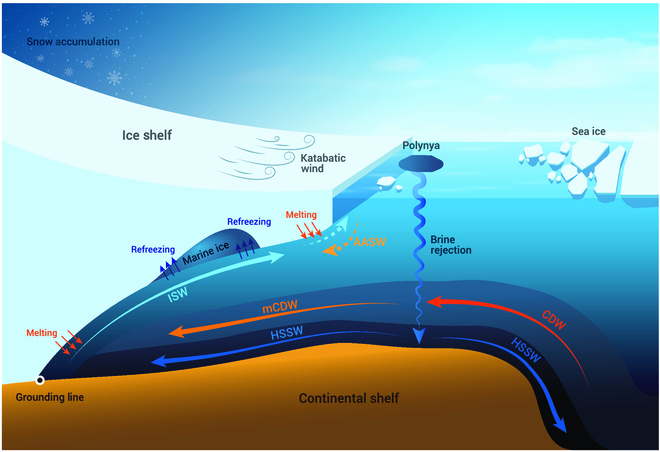Researchers’ findings were published in Ocean-land-Atmosphere Research on May 9.
“In this paper, we identify key multiscale oceanic processes that are responsible for heat delivery to the bases of the Antarctic ice shelves and review our current understanding of these processes,” said Zhaomin Wang, professor and first author of the study.
One of these processes responsible for heat delivery is circumpolar deep water (CDW).
CDW is a mix of the ocean’s water masses from different ocean basins, culminating in a warm, salty mass of water in the Southern Ocean. This water can cut through the base of ice shelves rapidly, leading to “cavities”, or cleaves in a glacier due to warm water currents. These cavities are then filled with warm-modified CDW and high salinity shelf water which eventually leads to loss of chunks from the tip of the glacier, known as “calving”. CDW and cavity development are substantial processes, along with basal melting and calving, in which the AIS loses its mass and consequently is a significant contributor to the rise in GMSL.
The effects CDW has on melting of Antarctic ice shelves, along with other mechanisms contributing to warm air and water circulation, are generally understood though they are poorly modeled with consistency. This may be due to not understanding small-scale processes, particularly when it comes to the effects eddies (short-lived oceanic circulation patterns) and the topography of cavities in the glacier have on melting.
“Both eddies and the dynamic effects of bottom topography have been proposed to be crucial in heat transport toward the fronts of ice shelves, in addition to heat transport by coastal currents,” Wang said.
These topographical subtleties help with understanding the transport of CDW and how coastal currents, surface winds, and bottom pressure torque all play into the interactions of these warm water currents with glacial masses and ice sheets.
In review, ice melting thanks to warm water isn’t as simple as it seems on the surface. Researchers surmised that while progress in learning the mechanisms in which oceanic warming is affecting the AIS is occurring, there needs to be improvement and innovation to assess where the continued melting of ice shelves in the Antarctic will leave humanity in the future. Retreating coastlines and GMSL rise are anticipated, though the levels to be expected are poorly understood.
Researchers suggest priorities are made, starting with improving cavity geometry, bathymetry (measuring the depth of water) and future projections of the mass balance of ice sheets. Spending time investigating small-scale processes may also provide valuable information leading to better future models being developed, and critically, determining what the mass loss of the AIS means for atmospheric, oceanic, and sea ice circulations.
China National Natural Science Foundation Projects, The Independent Research Foundation of Southern Marine Science and Engineering Guangdong Laboratory, and the National Science Foundation of Jiangsu Province made this research possible through funding.
Zhaomin Wang, Chengyan Liu, and Chen Cheng of Southern Marine Science and Engineering Guangdong Laboratory(Zhuhai), Qing Qin, Liangjun Yan, Jiangchao Qian, and Chong Sun of College of Oceanography at Hohai University, and Li Zhang of the School of Atmospheric Sciences at Sun Yat-sen University contributed to this research.


